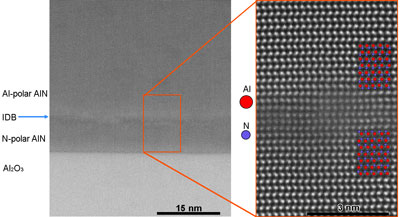Assessing Local Polarity in III-Nitrides Using AC-STEM
Home » Assessing Local Polarity in III-Nitrides Using AC-STEM
Different signals obtained through AC-STEM can provide direct observation
of local polarity switching.
Crystal polarity plays a significant role in materials properties. Controlling polarity in III-nitride semiconductors provides access to tailoring electronic or optoelectronic behavior. In many situations, it is important to monitor and control polarity locally to achieve intended electrical behavior; for example, devices that utilize lateral polar junctions. However, assessing local polarity requires extremely high spatial resolution and can be challenging from conventional imaging approaches. In this application note, we show how different signals obtained through aberration-corrected scanning transmission electron microscopy (AC-STEM) can provide direct observation of local polarity switching.
The figure to the right shows an example of an Al-polar AlN film grown on a sapphire substrate with an N-polar AlN buffer layer. The intensity in this high-angle annular dark-field (HAADF) scales roughly with atomic number where the larger bright spots correspond to Al atom columns (red in the model) and the smaller dimmer spots correspond to N atom columns (purple in the model). Download the application note to learn more.

STEM imaging and EDS analysis in a thick AlGaN epitaxial layer grown on a GaN substrate.
Would you like to learn more about AC-STEM?
Contact us today for your AC-STEM needs. Please complete the form below to have an EAG expert contact you.